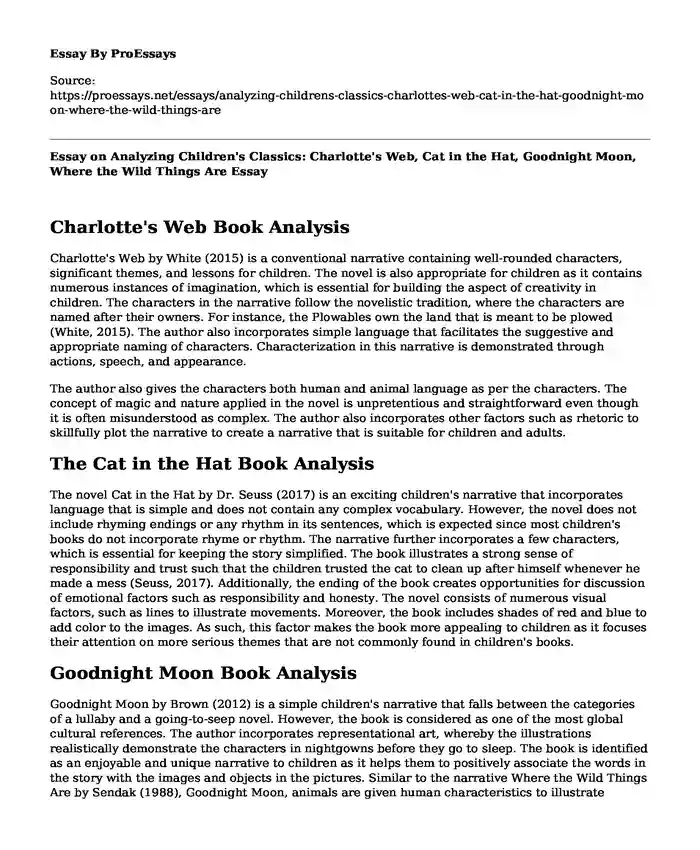Charlotte's Web Book Analysis
Charlotte's Web by White (2015) is a conventional narrative containing well-rounded characters, significant themes, and lessons for children. The novel is also appropriate for children as it contains numerous instances of imagination, which is essential for building the aspect of creativity in children. The characters in the narrative follow the novelistic tradition, where the characters are named after their owners. For instance, the Plowables own the land that is meant to be plowed (White, 2015). The author also incorporates simple language that facilitates the suggestive and appropriate naming of characters. Characterization in this narrative is demonstrated through actions, speech, and appearance.
The author also gives the characters both human and animal language as per the characters. The concept of magic and nature applied in the novel is unpretentious and straightforward even though it is often misunderstood as complex. The author also incorporates other factors such as rhetoric to skillfully plot the narrative to create a narrative that is suitable for children and adults.
The Cat in the Hat Book Analysis
The novel Cat in the Hat by Dr. Seuss (2017) is an exciting children's narrative that incorporates language that is simple and does not contain any complex vocabulary. However, the novel does not include rhyming endings or any rhythm in its sentences, which is expected since most children's books do not incorporate rhyme or rhythm. The narrative further incorporates a few characters, which is essential for keeping the story simplified. The book illustrates a strong sense of responsibility and trust such that the children trusted the cat to clean up after himself whenever he made a mess (Seuss, 2017). Additionally, the ending of the book creates opportunities for discussion of emotional factors such as responsibility and honesty. The novel consists of numerous visual factors, such as lines to illustrate movements. Moreover, the book includes shades of red and blue to add color to the images. As such, this factor makes the book more appealing to children as it focuses their attention on more serious themes that are not commonly found in children's books.
Goodnight Moon Book Analysis
Goodnight Moon by Brown (2012) is a simple children's narrative that falls between the categories of a lullaby and a going-to-seep novel. However, the book is considered as one of the most global cultural references. The author incorporates representational art, whereby the illustrations realistically demonstrate the characters in nightgowns before they go to sleep. The book is identified as an enjoyable and unique narrative to children as it helps them to positively associate the words in the story with the images and objects in the pictures. Similar to the narrative Where the Wild Things Are by Sendak (1988), Goodnight Moon, animals are given human characteristics to illustrate significant themes such as comfort to a child who has a deprived relationship with a parent. As such, the narrative incorporates the concept of "goodnight nobody" to comfort the children and help them feel like they are not alone in the room.
Where The Wild Things Are Book Analysis
The narrative Where the Wild Things Are by Sendak (1988) creates vivid imagery for the children as it is written in a child's mind to help the child's imagination grow. The texts in the narrative enable the children to predict what will happen next. The characters in the novel are given both animal and human characteristics despite them being monsters. Additionally, the narrative creates a sense of freedom among children as it portrays the child as a king of the wild things who controls the world. As such, adults may not be in favor of the book as it creates the message that even though children may not always get along with their parents, they can always find an escape where they will have unlimited freedom. One of my favorite things about this book is that it does not create any direct social justice issue since it suggests the possible relationship between children and their parents.
References
Brown, M. W. (2012). Goodnight moon. Macmillan Children's Books. https://archive.org/details/GoodnightMoon-ChildrensBook/page/n17/mode/2upSendak, M. (1988). Where the wild things are. HarperCollins. https://addi.ehu.es/bitstream/handle/10810/30027/JT_Where%20the%20Wild%20Things%20Are.pdf?sequence=2&isAllowed=y
Seuss. (2017). The cat in the hat. HarperCollins UK.
White, E. B. (2015). Charlotte's web. HarperCollins UK. https://cleveracademy.vn/wp-content/uploads/2016/10/Charlotte_s_Web_.pdf
Cite this page
Essay on Analyzing Children's Classics: Charlotte's Web, Cat in the Hat, Goodnight Moon, Where the Wild Things Are. (2023, Dec 17). Retrieved from https://proessays.net/essays/analyzing-childrens-classics-charlottes-web-cat-in-the-hat-goodnight-moon-where-the-wild-things-are
If you are the original author of this essay and no longer wish to have it published on the ProEssays website, please click below to request its removal:
- Application Letter for Nursing Course. Example
- Literary Analysis Essay on Children of the Sea by Edwidge Danticat
- Paper Example on Mars, The God of War
- Points of View on Courtly Love in Sir Gawain and the Green Knight - Essay Sample
- Essay Sample on Life Experience
- Cultural Issues in Standardized Tests: Analysis of the Latino and Hispanic Examinees
- Paper Sample on Covid-19: Airline Industry Needs Reshaping for Long-Term Survival







